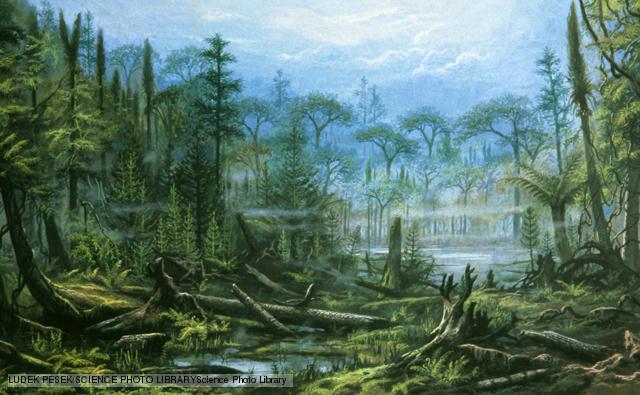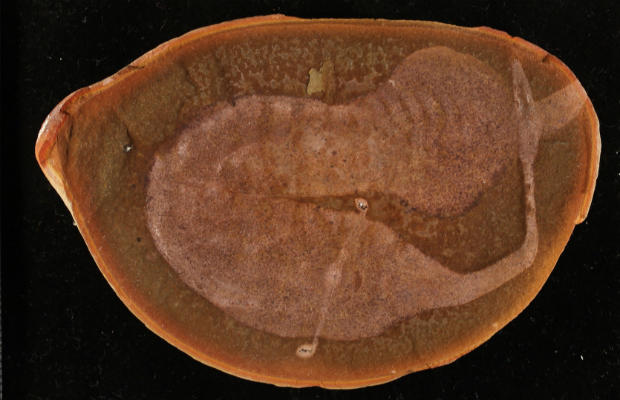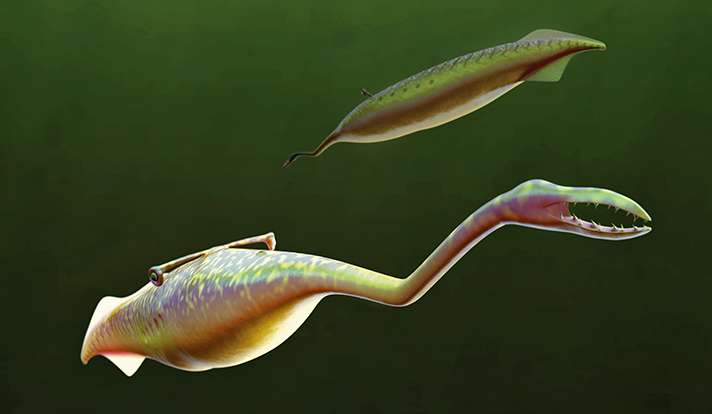“The great Tree of Life . . . fills with its dead and broken branches the crust of the earth, and covers the surface with its ever-branching and beautiful ramifications.” – Charles Darwin, On the Origin of Species
One of the miracles of science is its ability to extend human memory. As our computational and technological capabilities expand, the searchlight of history broadens our vision into our past and uncovers new revelations and mysteries alike. Few fields, then, provide more fascinating applications of science than the tireless efforts to trace the evolutionary relationships of creatures, dead and alive, who populate the tree of life.
Enter Tullimonstrum gregarium.
In the 1950s, Francis Tully discovered a bizarre fossil in Mazon Creek, Illinois — a site known for the quality and diversity of creatures preserved in its deposits, formed 300 million years ago in the Carboniferous period. For half a century, no one was quite sure what to make of the fossil, dubbed the Tully Monster and declared the state fossil of Illinois in 1989.. This oddly shaped sea creature did not fall under any neat category, with its pair of cuttlefish-like fins, long proboscis, and small sharp teeth. Indeed, paleontologists variously suggested the organism belonged to animal groups ranging from wormlike animals to mollusk-like creatures and even to fish.
A Yale-led research team, led by then graduate student Victoria McCoy has at last identified the Tully Monster. Combining morphological analysis and close examination of features resulting from the fossilization process, the researchers found that the Tully Monster was most likely a vertebrate with lamprey-like features. The study, published in April, has put to rest the mystery of the Tully Monster while also opening new avenues to further explore the life of this extraordinary animal.
The exemplary enigma

For a long time, the phylogenetic origins of the Tully Monster were unknown.
“It’s a classic example of what we generically call a ‘problematic fossil,’ which is a way of saying we don’t really know, or didn’t know, what it was or where it sat in the grand scheme of things,” said study co-author Derek Briggs, Professor of Geology and Geophysics at Yale and curator at the Yale Peabody Museum. There were a number of these problematic fossils in older rocks, particularly during the Cambrian explosion 530 million years ago, Briggs said.
This explosion of life saw the evolution of animals that would look alien to us today, but which were actually early offshoots of lineages leading to modern groups. Subsequently, most of these peculiar-looking fossils disappeared, replaced by groups more recognizable to paleontologists today.
“What we see in the fossil record later on are generally things that we can identify, or at least relate to living groups,” Briggs said. “The Tully Monster was one of those exceptions.” Present in Carboniferous rocks dating from about 300 million years ago, the Tully Monster was considered one of the problematica, or fossils that are difficult to classify. Besides its aquatic environment, no one really knew anything about it.
Previous solutions to this “problem of the problematica” included simply classifying the problematica as phyla that went extinct — in other words, they were considered a long, divergent branch of the evolutionary tree of life that had been cut short, rather than a branch more closely nested in ancestral animal groups. Though modern computational approaches to classification have resolved lingering questions about many previously problematic fossils, the Tully Monster had largely resisted phylogenic placement.
The mission begins
In 2015, McCoy was leading the Briggs lab group’s annual project, on which all the researchers in the group were collaborating.
“The Field Museum independently thought that they would want someone to look at the Tully Monster, so I independently met with the Field Museum and curators and collection managers at the Geological Society of America meeting,” McCoy said. “We both kind of simultaneously said we’d like to work on the Tully Monster.”

The Field Museum, in Illinois, is the closest major museum to Mazon Creek, where the majority of Tully Monster fossils have been unearthed. Its close relationship with local collectors has helped it acquire a vast collection of Tully Monster fossils — at over 2,000 specimens, the largest in the world — which made it the ideal location to work on the project, according to Briggs.
It’s elemental, not elementary
Part of what helped the Yale team succeed where others had failed was meticulous attention to detail. The fossilization process, though permitting long-term preservation, can make morphological features difficult to decipher as organisms decay and fossilize.
In total, the researchers examined around 1200 Tullimonstrum specimens, organ by organ, for general morphological features. As an example, at the end of the Tully Monster’s proboscis, the team counted and measured teeth structures and studied how they were situated in the Tully Monster’s claw structure. They also looked at features such as whether the eye bar sat at the top of the head or went through the center of the body.
The second component of the research involved studying features of preservation where the Tully Monster was discovered. The fossils were preserved as a discolored film on surrounding rock where the organism had been buried, and what appear to be morphological features sometimes are merely discoloration from the fossilization process.
This combined analysis of morphological and preservational features in the Tully Monster helped McCoy and the team conclude that the Tully Monster had a notochord, a cartilaginous skeletal rod and evolutionary precursor to the spine that classified the fossil as vertebrate. The researchers had noticed a long line running down the middle of specimens, previously identified as the gut of the organism. While it was entirely possible that the line was the fossil imprint of either a gut or a notochord, examining preservation in conjunction with morphology allowed the researchers to determine which feature it was.

To further test the vertebrate hypothesis, the researchers took specimen samples to Argonne National Laboratory for synchrotron analysis, a technique that allowed the team to determine which elements in a sample were enriched, what differences existed in the elemental composition of different tissues, and when they were preserved in the fossil. The synchrotron data indicated that Tully Monster eyes were often preserved in pyrite mineral, a preservational feature shared only by the fish — the other chordates — at the fossil site. This was particularly strong evidence that the Tully Monster was preserved similarly to fish, rather than other proposed animal groups, such as worms or mollusks.
The researchers also found that Tully Monster teeth had a distinct composition from that of the rest of the bifurcated, claw-like structure at the end of its proboscis. This discovery also pointed to chordate affinity, since arthropods, another previously proposed position for the Tully Monster, have teeth-like spikes made of the same material as their claw. Fish teeth, on the other hand, are biomineralized — minerals were produced in those tissues to harden them, making teeth tissue distinct from the rest of the fish’s mouth.
The teeth were pyritized, or replaced with iron sulfide, suggesting they were composed of sulfur-rich material, but not biomineralized, in contrast to most cartilaginous fishes, like sharks, whose fossils typically contain calcium or phosphate compounds. The sulfur-rich soft tissue was likely made of keratin, a sulfur-containing protein that is the main component of fingernails. Interestingly, keratin is also a component of hagfish and lamprey teeth, which do not biomineralize, so the researchers could conclude not only that the Tully Monster was a chordate, but also that it preserved similarly to soft-bodied fish like lampreys and hagfish.
A fossil’s future
Future studies of the Tully Monster include understanding its ecology and interactions with its environment and other organisms of the Carboniferous. It is unknown whether it was a parasite (like modern lampreys) or a scavenger, an ambush predator or one that could sustain periods of continuous swimming. Its many morphological oddities make it particularly compelling to study, according to McCoy.
Luckily for researchers, the Field Museum recently acquired more Tullimonstrum fossils, a collector’s gift that could provide researchers the opportunity to explore and refine their findings against the new specimens. An important step, according to Briggs, is to examine the new collection and see whether it supports the team’s conclusions. While the Tully Monster may be long dead and gone, the story of its existence is sure to fascinate generations to come.
Further Reading: Clements, T. “The Eyes of Tullimonstrum reveal a vertebrate affinity.” Nature 532, 500-503, 2016.
About the Author: Andrea Ouyang is a sophomore and prospective MCDB major in Davenport College.
Acknowledgments: The author is immensely grateful to Dr. Victoria McCoy and Professor Derek Briggs for their time and enthusiasm in speaking about their work.
Cover image: Yale researchers led by Victoria McCoy classified the Tully Monster as a vertebrate similar in morphology to modern lampreys. The fossil, discovered in the 1950s, had baffled paleontologists for decades. Image courtesy of Sean McMahon, YaleNews

